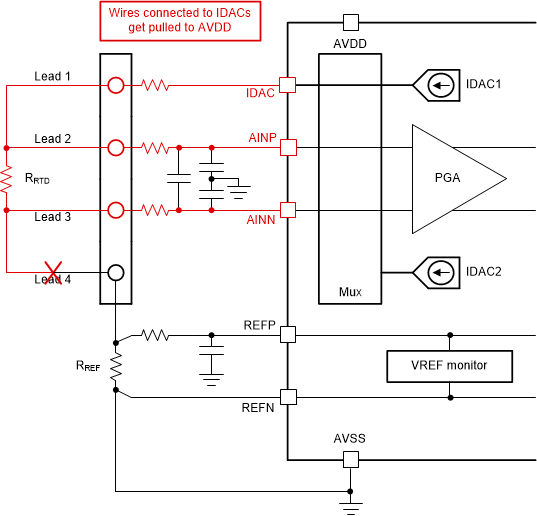SBAA483 February 2021 ADS1120 , ADS112C04 , ADS112U04 , ADS114S06 , ADS114S06B , ADS114S08 , ADS114S08B , ADS1220 , ADS122C04 , ADS122U04 , ADS124S06 , ADS124S08 , ADS125H02 , ADS1260 , ADS1261 , ADS1262 , ADS1263
- Abstract
- Trademarks
- 1Introduction
- 2Features Used to Detect Wire Breaks in RTD Systems
- 3Wire-Break Detection Methods for Different RTD Configurations
- 4Settling Time Considerations for RTD Wire-Break Detection
- 5Summary
- A How Integrated PGA Rail Detection Helps Identify Wire Breaks
- B Pseudo-Code for RTD Wire-Break Detection
A How Integrated PGA Rail Detection Helps Identify Wire Breaks
Although wire-break detection can be implemented using IDACs and VREF monitoring as described throughout this document, some ADCs integrate additional features to make wire-break detection easier.
One such feature is PGA rail detection, which allows the user to detect if the PGA output (or input, in some cases) is operating too close to the supply rails. This feature can be used to identify wire breaks because AINP or AINN can be pulled to AVDD when the IDAC no longer has a path to ground, as shown in Figure A-1. This feature can be employed during a diagnostic measurement routine to more accurately determine which pin has broken.
 Figure A-1 PGA Rail Detection Identifies
Overranged Inputs
Figure A-1 PGA Rail Detection Identifies
Overranged InputsThe ADS124S08 is an example of an ADC that integrates PGA rail detection features. If the level of the ADS124S08 PGA output voltage exceeds AVDD – 0.15 V, or drops below AVSS + 0.15 V, the ADC sets a flag to indicate that the output has gone beyond the output range of the PGA. Each PGA output (OUTN and OUTP) can trigger an overvoltage or undervoltage flag, giving a total of four flags:
- FL_P_RAILP (bit 5 of the STATUS byte): VOUTP has exceeded AVDD – 0.15 V
- FL_P_RAILN (bit 4 of the STATUS byte): VOUTP dropped below AVSS + 0.15 V
- FL_N_RAILP (bit 3 of the STATUS byte): VOUTN has exceeded AVDD – 0.15 V
- FL_N_RAILN (bit 2 of the STATUS byte): VOUTN dropped below AVSS + 0.15 V
For more information about the PGA rail detection features in a specific ADC, see that ADC data sheet. Table A-1 can also be referenced for a quick comparison of available features integrated into the precision delta-sigma ADCs highlighted in Table 1-1.
| Device | PGA Rail Detection Flags |
|---|---|
| ADS1120 | N/A |
| ADS112C04 | |
| ADS112U04 | |
| ADS1220 | |
| ADS122C04 | |
| ADS122U04 | |
| ADS114S06B |
|
| ADS114S08B | |
| ADS114S06 | |
| ADS114S08 | |
| ADS124S06 | |
| ADS124S08 | |
| ADS125H02 |
|
| ADS1260 |
|
| ADS1261 | |
| ADS1262 |
|
| ADS1263 |